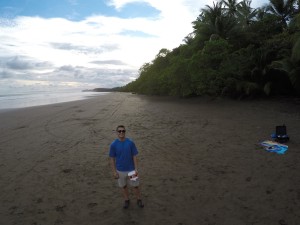Last year Lucy visited Bahia Ballena to get involved with Geoporter. She shares what she learned in her time with us.
- Costa Rica is one of the most incredible countries in the world. Don’t believe me? Browse Geoporter’s flickr for just a few moments to appreciate the incredible diversity of plant and animal life, the friendly and open nature of Ticos and Tica’s alike, and the awe inspiring weather, from rainstorms to breath-taking sunsets.

- Kids are fun! An afternoon geocaching with the young people that attend Forjando Alas youth group was amazing. Their enthusiasm to learn more about GPS technology and their energy to apply their knowledge RIGHT AWAY is infectious! Plus, it’s smiles all round when they answer the quiz questions you came up with correctly!

- We all have more to teach each other than we realise. Skills you might take for granted in yourself can be seen as incredibly valuable by another. Turns out, knowing how Facebook works and its little quirks is actually pretty handy to Geoporter and the growing businesses of Bahia Ballena.
- A GPS isn’t a compass (or an iPhone on map mode!). Note to self – spinning gets you nowhere!
- No matter where you are in the world, rubbish is still a sad reality of life. It has the potential to ruin paradise unless we take action. Luckily, Geoporter and the folks of Bahia Ballena are on the case.

- Learning a new language is HARD. But learning it is fun, especially when you get words mixed up! And when you finally start to get there – it’s so rewarding!
- Language is never a barrier to friendship. I will be eternally grateful to Flor for taking me into her home for a month, and to the (seemingly never ending!) stream of her family members who became my friends and helped me feel welcome in Bahia Ballena.

- GIS can generate more questions than answers! Geoporter has been on an incredible journey, mapping the trash of Bahia Ballena. Brilliant actions have been taken as a result of these maps, and the community continue to educate themselves about their waste. But, studying the maps always leaves new questions to be answered – what happens to the trash once it leaves the community? Are we sending the right type of trash to be recycled? Asking questions is vital to educate ourselves about the impact we have on the world around us, and Geoporter continues to do that.
- Water is an incredibly precious resource. We all know this of course, but living for a month in a community that’s developing rapidly and is working with Geoporter to map its water sources brought home just how vital it is that this resource is secured for all in the future.
- Sea levels are rising. Whilst millions of us already know this, coming face to face with the reality of rising tides in Bahia Ballena was shocking. Trees are being eaten up at an alarming rate, leaving beaches and wildlife without protection. Thankfully, Geoporter and the community of Bahia Ballena are taking steps to mitigate this, but the question still stands – will we still have coastal rainforests in ten years time?



































